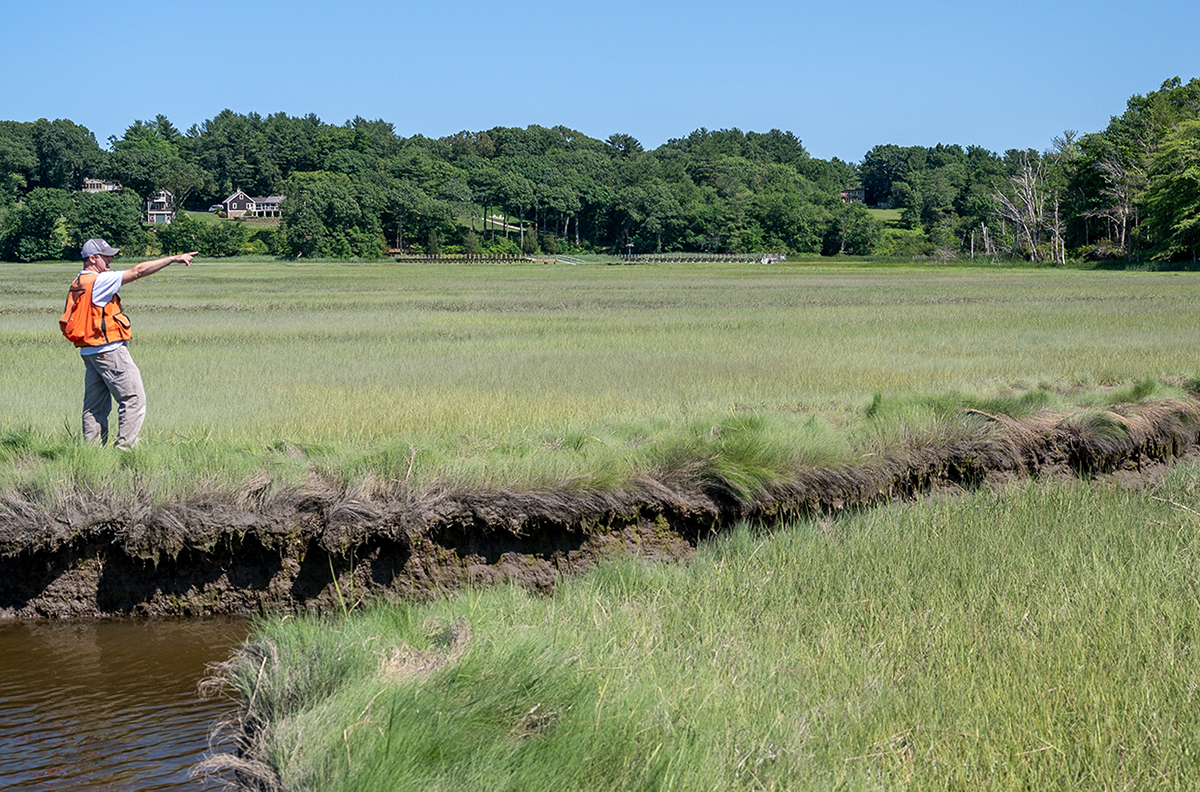Phelon Memorial Forest
A beautiful property with deep woodlands that open up to astonishing views,…

Location: Marshfield, MA
Size: 180 Acres
Amenities: Trails, Parking, Scenic Vistas, Rivers and Streams
It’s a half-hour after sunrise, and three miles to the east, the sun is still low over Massachusetts Bay. You stand and watch the mist burn off the tidal North River as birds go about their crepuscular business; if you get lucky, maybe a Bald Eagle or Great Blue Heron will fly overhead before you follow the trail back into the woods behind you.
While you keep an eye out for birds and plan your return hike, water slowly trickles through the earth beneath you—growing cleaner as it passes through—and makes its way first into the North River and then out to the ocean.
Dear reader, such an experience is yours to have at NEFF’s Nelson Memorial Forest. Maybe it’s time to plan a trip.
The almost peninsula-shaped Nelson Memorial Forest has beautiful waterside views and a great trail network that connects to two neighboring Town of Marshfield forestlands and a Wildlands Trust property, all within easier reach of major cities than many of NEFF’s Community Forests. Nelson is a 35-minute drive from downtown Boston and an hour from downtown Providence.

The property’s 1.5 miles of trails first wind through mature stands of primarily white pine and oak, as well as beech, hemlock, and spruce and fir. They then lead visitors to vantage points for Cove Brook, which runs along the property’s east side, and the North River, which runs along the northern edge of the property. These vantage points also provide views of one of Nelson’s most exciting features: the salt marsh.
The outer edge of Nelson Memorial Forest is a tidal salt marsh, a habitat type unique among NEFF’s Community Forests. From a distance, the marsh appears flat, but it has a slightly hummocked surface and is situated on “mucky fine sandy loam soils”—according to the property’s management plan—that can’t support trees due to tidal water flow. The area instead provides quality habitat for salt marsh wetland species.

A NEFF staff member stands on Nelson Memorial Forest’s tidal salt marsh, Twolined Studio
The marsh along Cove Brook in particular provides habitat for the Four-Toed Salamander, which was delisted from the Massachusetts Endangered Species Act in 2006 and is the smallest salamander species in Massachusetts.
The State of Massachusetts folded the marsh and similar habitat into river protection efforts as part of the 1978 Scenic & Recreational River Protective Order for the North River. According to the North River Commission, the order’s aim is “to protect public and private property, wildlife, fresh and saltwater fisheries, and irreplaceable wild, scenic and recreational river resources.” The order impacts the North River and some of its tributaries, and its area of jurisdiction is 300 feet from the natural banks of the North River.
As a result of this protective order and NEFF’s own guidelines about protecting riparian zones, no harvesting takes place at Nelson within 100 feet of the North River and its marshes, and only limited harvesting occurs within 300 feet. This strip of land helps protect the watershed from erosion-related sediment and a range of pollutants, as forests and marshes naturally filter water before it reaches rivers and streams.
The North River watershed and surrounding region have also benefited over the years from a great deal of land conservation. Nelson Memorial Forest is part of both a wildlife corridor around the river and a much larger band of conserved land that runs northwest to Wompatuck State Park.
Even the local wildlife corridor is extensive. Nelson is adjacent to or within two miles of another 3,000 acres of legally protected land, including Wildlands Trust’s Phillips Farm Preserve; the Town of Marshfield’s Cornhill Woodland, Highland Street Field, Cove Creek Nature Area, and Oak Street Woodland; Mass Audubon’s Tilden Farm Wildlife Sanctuary and North River Sanctuary; the Town of Norwell’s Procter Property, North River Conservation Land, and Farrar/Sinkewicz Property; North and South Rivers Watershed Association’s Stetson Meadows; and NEFF’s own Hagar Woods.
Much of New England’s remaining private forestland—particularly in the southern portion of the region—has been carved into parcels that are too small to single-handedly support the full suite of native wildlife. Roads and house lots that proliferate in this fragmented landscape can cut animals off from reproductive partners and force them into degraded habitat as they seek food and shelter. That makes contiguous conserved land like this crucial, particularly so close to a city the size of Boston.
Nelson Memorial Forest makes an impact both as a small piece in a large habitat puzzle, and on its individual merits as a fascinating riverside forestland.
Plan a visit to Nelson Memorial Forest or one of NEFF’s other Community Forests.
Nelson Memorial Forest’s first 108 acres were donated to NEFF in 1958 by Miss Katharine Dorothea Nelson. Her heirs—Margaret H. Milholland, Anne Felton Spencer, Hugh Kingsbury Tyson and Penelope L. Adams—donated an adjacent parcel 19 years later to expand the forest.